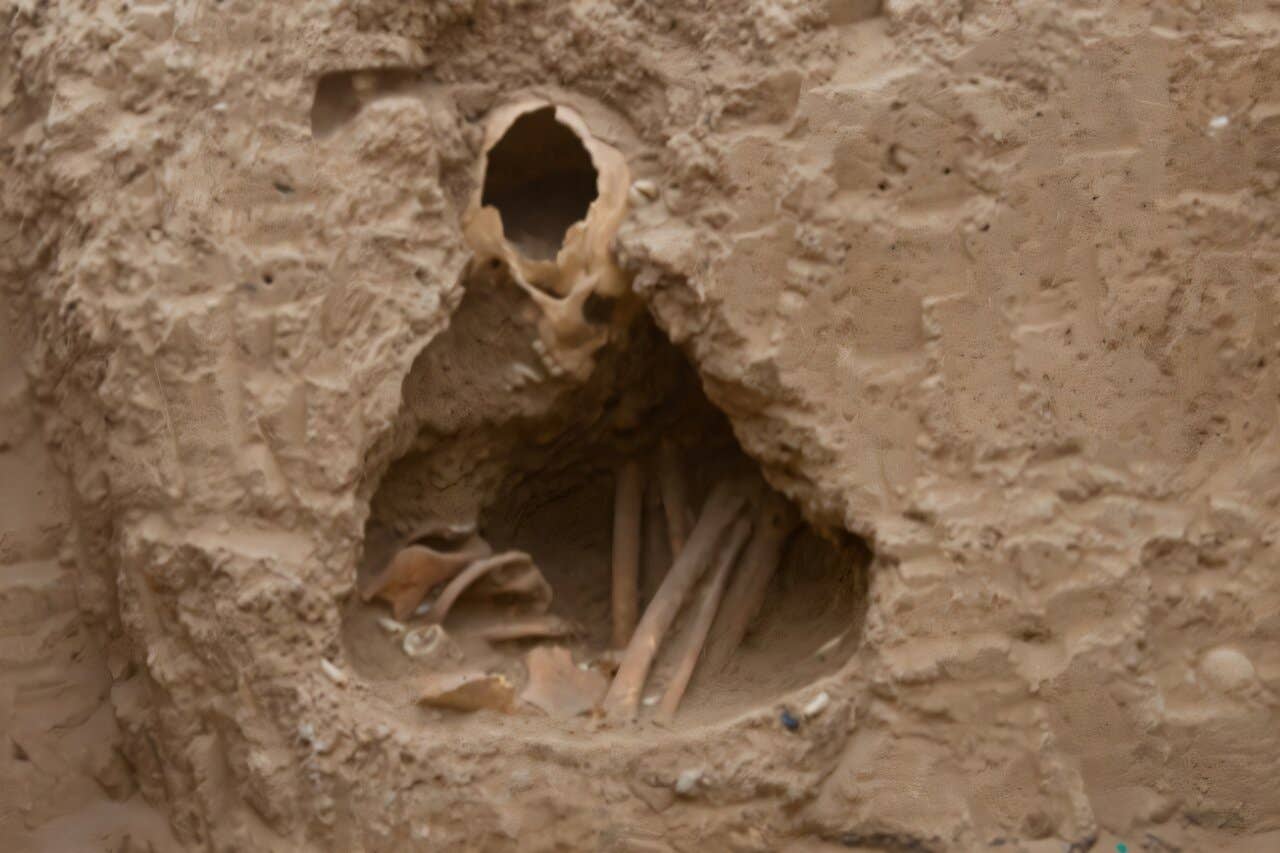Ancient teeth reveal how the world’s earliest farmers lived, moved, and socialized
Chemical clues in ancient Syrian teeth reveal how early farmers stayed local yet welcomed outsiders into their growing villages.

One of the burials found at the Neolithic site of Tell Halula in Syria. (CREDIT: Grup de Recerca en Arqueologia del Mediterrani i del Proxim Orient (GRAMPO), Seminari d’Arqueologia Prehistòrica del Pròxim Orient (SAPPO))
Archaeologists have learned about the lives of the world's earliest farmers, how they traveled, and socialized in Neolithic north Syria between about 11,600 and 7,500 years ago. Using advanced chemical analysis on human teeth, scientists at Liverpool and Durham universities pieced together a story about how prehistoric villagers created settlements, welcomed strangers, and had local origins and distant contacts.
The Neolithic era was a monumental step in the evolution of mankind with nomadic hunter-gatherers living in fixed villages and beginning to grow plants. In northern Syria today, people passed through several stages: the Pre-Pottery Neolithic A (PPNA), Pre-Pottery Neolithic B (PPNB), and the Late Neolithic. Human beings transitioned from small, ephemeral settlements to larger, more settled societies around animal husbandry and agriculture during these years.
By the Late Neolithic, besides making pottery, people were also integrating settled agriculture with mobile pastoralism. The blending of lifestyles raised some questions: What level of mobility was there? Were groups closed or open to outsiders? And how did early societies incorporate newcomers?
Teeth as Time Capsules
To answer these questions, the researchers analyzed strontium and oxygen isotopes embedded in tooth enamel of 71 people buried at five archaeological locations—Cheikh Hassan, Mureybet, Dja'de el-Mughara, Halula, and Sabi Abyad. The isotopes act as geological fingerprints to tell where a person grew up. If the chemical makeup of a tooth was not local, then that person had grown up elsewhere.
The isotope values varied subtly across sites. Most individuals had local baseline-matching isotope values, which means they most likely came of age in the same place where they were buried. But not everyone. Eleven of them carried non-local signatures, which meant they came into these groups later in life. In certain sites, for instance, Sabi Abyad, nearly a quarter of the sampled individuals had non-local origins.
What the Data Reveal
In the early Neolithic, people were primarily sedentary. The societies were small, settled, and independent. Few foreigners arrived to live among them, and most individuals received burials near where they were born. It was at around the same time that permanent settlements, routine burial practices, and a feeling of identification with specific landscapes started developing.
Over time, though, trends did emerge. More mobility took place during the Late Neolithic. The study uncovered that an unknown number of individuals—especially women—had isotope signatures indicating that they were born somewhere else beyond the villages where they were buried.
The trend is evidence of a social system whereby women would have migrated to the families of their husbands, a system which is referred to as patrilocality. Such mobility would have been advantageous for communities through sharing information, goods, and genes and through avoiding incest.
Lead researcher Dr. Jo-Hannah Plug, who is now at the University of Oxford, said the finding fills in the gap between archaeology of artifacts and buildings and the immediate migration of humans. "For the first time, our research gives direct evidence for the migration of people during this period," Plug said. "The fact that especially women were on the move indicates their likely important role in innovation and the establishment of cross-regional networks."
Shared Lives and Equal Burials
The most insightful of the research findings were social equality in burial practices. Non-members were not segregated or singled out from locals who were born in the community. They were buried with locals, often in extended family houses or communal burial places, and given equal ceremonial treatment.
At Tell Halula, for instance, a group of individuals buried together under the floor of a house were both locals and outsiders. Both were treated to the same funeral rites—tastefully posed corpses, similar grave offerings, and sometimes even fancy post-mortem activities such as burning. At Sabi Abyad, five of six non-locals identified were female, but they all were buried among locals in community cemeteries, which proves complete social integration.
Dr. Eva Fernandez-Dominguez, the lead author at Durham University, said the findings were a show of early community openness. "We found that villagers were generally adhering to local, but they welcomed outsiders who appeared to be fully integrated into social and burial life," she stated. "The fact that women also migrated between villages suggests that there were advanced social dynamics in the first permanent settlements of the world."
A Dynamic View of Early Life
The research describes early village life as being neither closed nor open. With the stabilization of the villages during the middle Neolithic, people stayed put, with stronger kin and land ties. With the extension of agriculture further and the storage and exchange facilitated through pottery as larger, the networks increased. Societies were more dynamic, and with social mobility, especially for women, increasing.
By tracing the chemistry of ancient teeth, scientists are now able to observe how mobility evolved through farming, tool production, and ritual life. The isotopic data suggests that the origins of modern social networks stretch much farther back in time than had been imagined. Early farmers were not isolated individuals—they were mobile, trading, and adjusting in a world of shifting boundaries and potentialities.
The study illustrates the power of modern scientific techniques to illuminate aspects of past life that have no material expression in buildings or artifacts. Isotopic analysis enables researchers to trace human travel, revealing patterns of migration that are unseen by traditional archaeology.
In combining chemistry and burial analysis, the study presents a more comprehensive vision of social organization in one of the world's earliest agricultural regions. It also fills an important gap in our knowledge of the Northern Levant, a crucial conduit through which agriculture traveled from its point of origin in the Fertile Crescent into Europe and beyond.
Practical Implications of the Research
This research not only reconstructs the manner in which early humans lived but also reshapes our understanding of social organization, gender roles, and migration. It shows that even within the earliest settlements of humanity, societies were capable of experiencing strong local affiliation coupled with their acceptance of outsiders.
Inclusion of migrants—especially women—in these societies suggests that cooperative and social exchange were essential to human success during the shift towards agriculture.
These findings can help present-day researchers who study migration, adaptation, and social cohesion in the current era by showing that mixing mobility and roots has been central to human existence for millennia.
Research findings are available online in the journal Nature Scientific Reports.
Related Stories
- New research reveals how early humans transformed the world through farming
- Fossilized teeth reveal a risky diet change spurred human evolution
- Why saber-toothed predators evolved their razer-sharp teeth
Like these kind of feel good stories? Get The Brighter Side of News' newsletter.
Joshua Shavit
Science & Technology Writer and Editor
Joshua Shavit is a Los Angeles-based science and technology writer with a passion for exploring the breakthroughs shaping the future. As a co-founder of The Brighter Side of News, he focuses on positive and transformative advancements in AI, technology, physics, engineering, robotics and space science. Joshua is currently working towards a Bachelor of Science in Business and Industrial Engineering at the University of California, Berkeley. He combines his academic background with a talent for storytelling, making complex scientific discoveries engaging and accessible. His work highlights the innovators behind the ideas, bringing readers closer to the people driving progress.



